Chapter 6 Application Of Derivatives Miscellaneous Exercise
Miscellaneous Exercise on Chapter 6
1. Show that the function given by $f(x)=\frac{\log x}{x}$ has maximum at $x=e$.
Show Answer
Solution
The given function is $f(x)=\frac{\log x}{x}$.
$ f^{\prime}(x)=\frac{x(\frac{1}{x})-\log x}{x^{2}}=\frac{1-\log x}{x^{2}} $
Now, $f^{\prime}(x)=0$
$\Rightarrow 1-\log x=0$ $\Rightarrow \log x=1$
$\Rightarrow \log x=\log e$
$\Rightarrow x=e$
Now, $f^{\prime \prime}(x)=\frac{x^{2}(-\frac{1}{x})-(1-\log x)(2 x)}{x^{4}}$
$ \begin{aligned} & =\frac{-x-2 x(1-\log x)}{x^{4}} \\ & =\frac{-3+2 \log x}{x^{3}} \end{aligned} $
Now, $f^{\prime \prime}(e)=\frac{-3+2 \log e}{e^{3}}=\frac{-3+2}{e^{3}}=\frac{-1}{e^{3}}<0$
Therefore, by second derivative test, $f$ is the maximum at $x=e$.
2. The two equal sides of an isosceles triangle with fixed base $b$ are decreasing at the rate of $3 cm$ per second. How fast is the area decreasing when the two equal sides are equal to the base?
Show Answer
Solution
Let $\triangle A B C$ be isosceles where $B C$ is the base of fixed length $b$.
Let the length of the two equal sides of $\triangle A B C$ be $a$.
Draw AD $\square BC$.
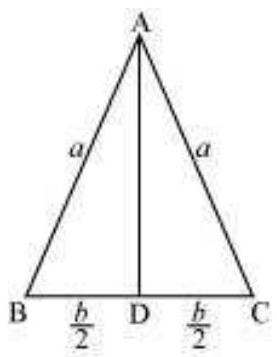
Now, in $\triangle A D C$, by applying the Pythagoras theorem, we have:
$AD=\sqrt{a^{2}-\frac{b^{2}}{4}}$
Area of triangle
$ (A)=\frac{1}{2} b \sqrt{a^{2}-\frac{b^{2}}{4}} $
The rate of change of the area with respect to time $(t)$ is given by,
$\frac{d A}{d t}=\frac{1}{2} b \cdot \frac{2 a}{2 \sqrt{a^{2}-\frac{b^{2}}{4}}} \frac{d a}{d t}=\frac{a b}{\sqrt{4 a^{2}-b^{2}}} \frac{d a}{d t}$
It is given that the two equal sides of the triangle are decreasing at the rate of $3 cm$ per second.
$ \begin{aligned} & \\ & \square \frac{d a}{d t}=-3 cm / s \\ & \therefore \frac{d A}{d t}=\frac{-3 a b}{\sqrt{4 a^{2}-b^{2}}} \end{aligned} $
Then, when $a=b$, we have:
$\frac{d A}{d t}=\frac{-3 b^{2}}{\sqrt{4 b^{2}-b^{2}}}=\frac{-3 b^{2}}{\sqrt{3 b^{2}}}=-\sqrt{3} b$
Hence, if the two equal sides are equal to the base, then the area of the triangle is decreasing at the rate of $\sqrt{3} bm cm^{2} / s$.
3. Find the intervals in which the function $f$ given by
$$ f(x)=\frac{4 \sin x-2 x-x \cos x}{2+\cos x} $$
is (i) increasing (ii) decreasing.
Show Answer
Solution
$f(x)=\frac{4 \sin x-2 x-x \cos x}{2+\cos x}$
$\therefore f^{\prime}(x)=\frac{(2+\cos x)(4 \cos x-2-\cos x+x \sin x)-(4 \sin x-2 x-x \cos x)(-\sin x)}{(2+\cos x)^{2}}$
$=\frac{(2+\cos x)(3 \cos x-2+x \sin x)+\sin x(4 \sin x-2 x-x \cos x)}{(2+\cos x)^{2}}$
$=\frac{6 \cos x-4+2 x \sin x+3 \cos ^{2} x-2 \cos x+x \sin x \cos x+4 \sin ^{2} x-2 x \sin x-x \sin x \cos x}{(2+\cos x)^{2}}$
$=\frac{4 \cos x-4+3 \cos ^{2} x+4 \sin ^{2} x}{(2+\cos x)^{2}}$
$=\frac{4 \cos x-4+3 \cos ^{2} x+4-4 \cos ^{2} x}{(2+\cos x)^{2}}$
$=\frac{4 \cos x-\cos ^{2} x}{(2+\cos x)^{2}}=\frac{\cos x(4-\cos x)}{(2+\cos x)^{2}}$
Now, $f^{\prime}(x)=0$
$\Rightarrow \cos x=0$ or $\cos x=4$
But, $\cos x \neq 4$
$\square \cos x=0$
$\Rightarrow x=\frac{\pi}{2}, \frac{3 \pi}{2}$
Now, $x=\frac{\pi}{2}$ and $x=\frac{3 \pi}{2}$ divides $(0,2 \pi)$ into three disjoint intervals i.e.,
$(0, \frac{\pi}{2}),(\frac{\pi}{2}, \frac{3 \pi}{2})$, and $(\frac{3 \pi}{2}, 2 \pi)$.
In intervals $(0, \frac{\pi}{2})$ and $(\frac{3 \pi}{2}, 2 \pi), f^{\prime}(x)>0$.
Thus, $f(x)$ is increasing for $0<x<\frac{x}{2}$ and $\frac{3 \pi}{2}<x<2 \pi$.
In the interval $(\frac{\pi}{2}, \frac{3 \pi}{2}), f^{\prime}(x)<0$.
Thus, $f(x)$ is decreasing for $\frac{\pi}{2}<x<\frac{3 \pi}{2}$.
4. Find the intervals in which the function $f$ given by $f(x)=x^{3}+\frac{1}{x^{3}}, x \neq 0$ is
(i) increasing
(ii) decreasing.
Show Answer
Solution
$f(x)=x^{3}+\frac{1}{x^{3}}$
$\therefore f^{\prime}(x)=3 x^{2}-\frac{3}{x^{4}}=\frac{3 x^{6}-3}{x^{4}}$
Then, $f^{\prime}(x)=0 \Rightarrow 3 x^{6}-3=0 \Rightarrow x^{6}=1 \Rightarrow x= \pm 1$
Now, the points $x=1$ and $x=-1$ divide the real line into three disjoint intervals
i.e., $(-\infty,-1),(-1,1)$, and $(1, \infty)$.
In intervals $(-\infty,-1)$ and $(1, \infty)$ i.e., when $x<-1$ and $x>1, f^{\prime}(x)>0$.
Thus, when $x<-1$ and $x>1, f$ is increasing.
In interval $(-1,1)$ i.e., when $-1<x<1, f^{\prime}(x)<0$.
Thus, when $-1<x<1, f$ is decreasing.
5. Find the maximum area of an isosceles triangle inscribed in the ellipse $\frac{x^{2}}{a^{2}}+\frac{y^{2}}{b^{2}}=1$ with its vertex at one end of the major axis.
Show Answer
Solution
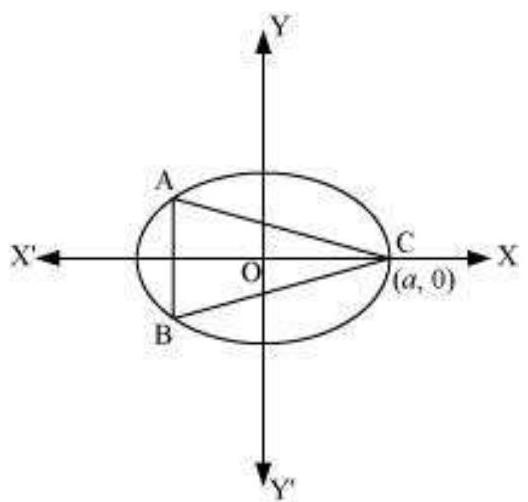
The given ellipse is $\frac{x^{2}}{a^{2}}+\frac{y^{2}}{b^{2}}=1$.
Let the major axis be along the $x$-axis.
Let $A B C$ be the triangle inscribed in the ellipse where vertex $C$ is at $(a, 0)$.
Since the ellipse is symmetrical with respect to the $x$-axis and $y$-axis, we can assume the coordinates of $A$ to be $(-x_1, y_1)$ and the coordinates of $B$ to be $(-x_1,-y_1)$.
Now, we have $y_1= \pm \frac{b}{a} \sqrt{a^{2}-x_1^{2}}$.
$\square$ Coordinates of $A$ are $(-x_1, \frac{b}{a} \sqrt{a^{2}-x_1^{2}})$ and the coordinates of $B$ are $(x_1,-\frac{b}{a} \sqrt{a^{2}-x_1^{2}})$.
As the point $(x_1, y_1)$ lies on the ellipse, the area of triangle $ABC(A)$ is given by,
$ \begin{aligned} & A=\frac{1}{2}|a(\frac{2 b}{a} \sqrt{a^{2}-x_1^{2}})+(-x_1)(-\frac{b}{a} \sqrt{a^{2}-x_1^{2}})+(-x_1)(-\frac{b}{a} \sqrt{a^{2}-x_1^{2}})| \\ & \Rightarrow A=b \sqrt{a^{2}-x_1^{2}}+x_1 \frac{b}{a} \sqrt{a^{2}-x_1^{2}} \\ & \therefore \frac{d A}{d x_1}=\frac{-2 x_1 b}{2 \sqrt{a^{2}-x_1^{2}}}+\frac{b}{a} \sqrt{a^{2}-x_1^{2}}-\frac{2 b x_1^{2}}{a 2 \sqrt{a^{2}-x_1^{2}}} \\ & =\frac{b}{a \sqrt{a^{2}-x_1^{2}}}[-x_1 a+(a^{2}-x_1^{2})-x_1^{2}] \\ & =\frac{b(-2 x_1^{2}-x_1 a+a^{2})}{a \sqrt{a^{2}-x_1^{2}}} \end{aligned} $
Now, $\frac{d A}{d x_1}=0$
$\Rightarrow-2 x_1^{2}-x_1 a+a^{2}=0$
$\Rightarrow x_1=\frac{a \pm \sqrt{a^{2}-4(-2)(a^{2})}}{2(-2)}$
$=\frac{a \pm \sqrt{9 a^{2}}}{-4}$
$=\frac{a \pm 3 a}{-4}$
$\Rightarrow x_1=-a, \frac{a}{2}$
But, $x_1$ cannot be equal to $a$. $\therefore x_1=\frac{a}{2} \Rightarrow y_1=\frac{b}{a} \sqrt{a^{2}-\frac{a^{2}}{4}}=\frac{b a}{2 a} \sqrt{3}=\frac{\sqrt{3} b}{2}$
Now, $\frac{d^{2} A}{d x_1^{2}}=\frac{b}{a}{\frac{\sqrt{a^{2}-x_1^{2}}(-4 x_1-a)-(-2 x_1^{2}-x_1 a+a^{2}) \frac{(-2 x_1)}{2 \sqrt{a^{2}-x_1^{2}}}}{a^{2}-x_1^{2}}}$
$ =\frac{b}{a}{\frac{(a^{2}-x_1^{2})(-4 x_1-a)+x_1(-2 x_1^{2}-x_1 a+a^{2})}{(a^{2}-x_1^{2})^{\frac{3}{2}}}} $
$ =\frac{b}{a}{\frac{2 x^{3}-3 a^{2} x-a^{3}}{(a^{2}-x_1^{2})^{\frac{3}{2}}}} $
Also, when $x_1=\frac{a}{2}$, then
$ \begin{aligned} \frac{d^{2} A}{d x_1^{2}} & =\frac{b}{a}{\frac{2 \frac{a^{3}}{8}-3 \frac{a^{3}}{2}-a^{3}}{(\frac{3 a^{2}}{4})^{\frac{3}{2}}}}=\frac{b}{a}{\frac{\frac{a^{3}}{4}-\frac{3}{2} a^{3}-a^{3}}{(\frac{3 a^{2}}{4})^{\frac{3}{2}}}} \\ & =-\frac{b}{a}{\frac{\frac{9}{4} a^{3}}{(\frac{3 a^{2}}{4})^{\frac{3}{2}}}}<0 \end{aligned} $
Thus, the area is the maximum when $x_1=\frac{a}{2}$.
$\square$ Maximum area of the triangle is given by,
$ \begin{aligned} A & =b \sqrt{a^{2}-\frac{a^{2}}{4}}+(\frac{a}{2}) \frac{b}{a} \sqrt{a^{2}-\frac{a^{2}}{4}} \\ & =a b \frac{\sqrt{3}}{2}+(\frac{a}{2}) \frac{b}{a} \times \frac{a \sqrt{3}}{2} \\ & =\frac{a b \sqrt{3}}{2}+\frac{a b \sqrt{3}}{4}=\frac{3 \sqrt{3}}{4} a b \end{aligned} $
6. A tank with rectangular base and rectangular sides, open at the top is to be constructed so that its depth is $2 m$ and volume is $8 m^{3}$. If building of tank costs Rs 70 per sq metres for the base and Rs 45 per square metre for sides. What is the cost of least expensive tank?
Show Answer
Solution
Let $l, b$, and $h$ represent the length, breadth, and height of the tank respectively.
Then, we have height $(h)=2 m$
Volume of the tank $=8 m^{3}$
Volume of the tank $=l \times b \times h$
$\square 8=l \times b \times 2$
$\Rightarrow l b=4 \Rightarrow b=\frac{4}{l}$
Now, area of the base $=I b=4$
Area of the 4 walls $(A)=2 h(I+b)$
$\therefore A=4(l+\frac{4}{l})$
$\Rightarrow \frac{d A}{d l}=4(1-\frac{4}{l^{2}})$
Now, $\frac{d A}{d l}=0$
$\Rightarrow 1-\frac{4}{l^{2}}=0$
$\Rightarrow l^{2}=4$
$\Rightarrow l= \pm 2$
However, the length cannot be negative.
Therefore, we have $I=4$.
$\therefore b=\frac{4}{l}=\frac{4}{2}=2$
Now, $\frac{d^{2} A}{d l^{2}}=\frac{32}{l^{3}}$
When $l=2, \frac{d^{2} A}{d l^{2}}=\frac{32}{8}=4>0$.
Thus, by second derivative test, the area is the minimum when $I=2$.
We have $I=b=h=2$.
$\square$ Cost of building the base $=Rs 70 \times(I b)=Rs 70(4)=Rs 280$
Cost of building the walls $=Rs 2 h(I+b) \times 45=Rs 90(2)(2+2)$
$=Rs 8(90)=Rs 720$
Required total cost $=Rs(280+720)=Rs 1000$
Hence, the total cost of the tank will be Rs 1000.
7. The sum of the perimeter of a circle and square is $k$, where $k$ is some constant. Prove that the sum of their areas is least when the side of square is double the radius of the circle.
Show Answer
Solution
Let $r$ be the radius of the circle and $a$ be the side of the square.
Then, we have:
$2 \pi r+4 a=k$ (where $k$ is constant)
$\Rightarrow a=\frac{k-2 \pi r}{4}$
The sum of the areas of the circle and the square $(A)$ is given by,
$A=\pi r^{2}+a^{2}=\pi r^{2}+\frac{(k-2 \pi r)^{2}}{16}$
$\therefore \frac{d A}{d r}=2 \pi r+\frac{2(k-2 \pi r)(-2 \pi)}{16}=2 \pi r-\frac{\pi(k-2 \pi r)}{4}$
Now, $\frac{d A}{d r}=0$
$\Rightarrow 2 \pi r=\frac{\pi(k-2 \pi r)}{4}$
$8 r=k-2 \pi r$
$\Rightarrow(8+2 \pi) r=k$
$\Rightarrow r=\frac{k}{8+2 \pi}=\frac{k}{2(4+\pi)}$
Now, $\frac{d^{2} A}{d r^{2}}=2 \pi+\frac{\pi^{2}}{2}>0$
$\therefore$ When $r=\frac{k}{2(4 \pi)}, \frac{d^{2} A}{d r^{2}}>0$.
When $r=\frac{k}{2(4 \pi)}, a=\frac{k-2 \pi[\frac{k}{2(4 \pi)}]}{4}=\frac{k(4 \pi) \pi k}{4(\pi)}=\frac{4 k}{4(\pi)}=\frac{k}{\pi}=2 r$.
Hence, it has been proved that the sum of their areas is least when the side of the square is double the radius of the circle.
8. A window is in the form of a rectangle surmounted by a semicircular opening. The total perimeter of the window is $10 m$. Find the dimensions of the window to admit maximum light through the whole opening.
Show Answer
Solution
Let $x$ and $y$ be the length and breadth of the rectangular window.
Radius of the semicircular opening $=\frac{x}{2}$
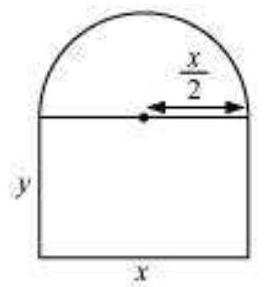
It is given that the perimeter of the window is $10 m$.
$\therefore x+2 y+\frac{\pi x}{2}=10$
$\Rightarrow x(1+\frac{\pi}{2})+2 y=10$
$\Rightarrow 2 y=10-x(1+\frac{\pi}{2})$
$\Rightarrow y=5-x(\frac{1 \pi}{2}+\frac{-}{4})$
$\square$ Area of the window $(A)$ is given by,
$ \begin{aligned} A & =x y+\frac{\pi}{2}(\frac{x}{2})^{2} \\ & =x[5-x(\frac{1 \pi}{2}+\frac{\pi}{4})]+\frac{x^{2}}{8} \\ & =5 x-x^{2}(\frac{1 \pi}{2}+\frac{\pi}{4})+\frac{\pi}{8} x^{2} \\ \therefore & \frac{d A}{d x}=5-2 x(\frac{1 \pi}{2}+\frac{\pi}{4})+\frac{\pi}{4} x \\ & =5-x(1+\frac{\pi}{2})+\frac{\pi}{4} x \\ \therefore & \frac{d^{2} A}{d x^{2}}=-(1+\frac{\pi}{2})+\frac{\pi}{4}=-1-\frac{\pi}{4} \end{aligned} $
Now, $\frac{d A}{d x}=0$
$\Rightarrow 5-x(1+\frac{\pi}{2})+\frac{\pi}{4} x=0$
$\Rightarrow 5-x-\frac{\pi}{4} x=0$
$\Rightarrow x(1+\frac{\pi}{4})=5$
$\Rightarrow x=\frac{5}{(1+\frac{\pi}{4})}=\frac{20}{\pi+4}$
Thus, when $x=\frac{20}{\pi+4}$ then $\frac{d^{2} A}{d x^{2}}<0$.
Therefore, by second derivative test, the area is the maximum when length $x=\frac{20}{\pi+4} m$. Now,
$y=5-\frac{20}{\pi+4}(\frac{2+\pi}{4})=5-\frac{5(2+\pi)}{\pi+4}=\frac{10}{\pi+4} m$
Hence, the required dimensions of the window to admit maximum light is given
by length $=\frac{20}{\pi+4} m$ and breadth $=\frac{10}{\pi+4} m$.
9. A point on the hypotenuse of a triangle is at distance $a$ and $b$ from the sides of the triangle.Show that the minimum length of the hypotenuse is
$\left(a^{\frac{2}{3}}+b^{\frac{2}{3}}\right)^{\frac{3}{2}}$.
Show Answer
Solution
Let $\triangle A B C$ be right-angled at $B$. Let $A B=x$ and $B C=y$.
Let $P$ be a point on the hypotenuse of the triangle such that $P$ is at a distance of $a$ and $b$ from the sides $A B$ and $B C$ respectively.
Let $\square C=\theta$.
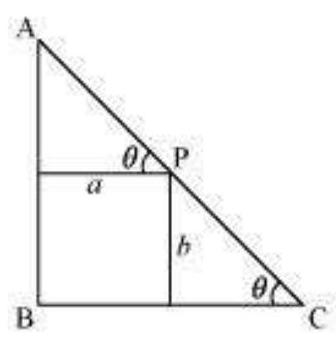
We have,
$AC=\sqrt{x^{2}+y^{2}}$
Now,
$PC=b cosec \theta$
And, $AP=a \sec \theta$
$\square AC=AP+PC$
$\square AC=b cosec \theta+a \sec \theta \ldots$ (1)
$\therefore \frac{d(AC)}{d \theta}=-b cosec \theta \cot \theta+a \sec \theta \tan \theta$
$\therefore \frac{d(AC)}{d \theta}=0$
$\Rightarrow a \sec \theta \tan \theta=b cosec \theta \cot \theta$
$\Rightarrow \frac{a}{\cos \theta} \cdot \frac{\sin \theta}{\cos \theta}=\frac{b}{\sin \theta} \frac{\cos \theta}{\sin \theta}$
$\Rightarrow a \sin ^{3} \theta=b \cos ^{3} \theta$
$\Rightarrow(a)^{\frac{1}{3}} \sin \theta=(b)^{\frac{1}{3}} \cos \theta$
$\Rightarrow \tan \theta=(\frac{b}{a})^{\frac{1}{3}}$
$\therefore \sin \theta=\frac{(b)^{\frac{1}{3}}}{\sqrt{a^{\frac{2}{3}}+b^{\frac{2}{3}}}}$ and $\cos \theta=\frac{(a)^{\frac{1}{3}}}{\sqrt{a^{\frac{2}{3}}+b^{\frac{2}{3}}}}$
It can be clearly shown that $\frac{d^{2}(AC)}{d \theta^{2}}<0$ when $\tan \theta=(\frac{b}{a})^{\frac{1}{3}}$.
Therefore, by second derivative test, the length of the hypotenuse is the maximum when
$\tan \theta=(\frac{b}{a})^{\frac{1}{3}}$.
Now, when $\tan \theta=(\frac{b}{a})^{\frac{1}{3}}$, we have:
$ \begin{aligned} AC & =\frac{b \sqrt{a^{\frac{2}{3}}+b^{\frac{2}{3}}}}{b^{\frac{1}{3}}}+\frac{a \sqrt{a^{\frac{2}{3}}+b^{\frac{2}{3}}}}{a^{\frac{1}{3}}} \\ & =\sqrt{a^{\frac{2}{3}}+b^{\frac{2}{3}}}(b^{\frac{2}{3}}+a^{\frac{2}{3}}) \\ & =(a^{\frac{2}{3}}+b^{\frac{2}{3}})^{\frac{3}{2}} \end{aligned} $
Hence, the maximum length of the hypotenuses is $(a^{\frac{2}{3}}+b^{\frac{2}{3}})^{\frac{3}{2}}$.
10. Find the points at which the function $f$ given by $f(x)=(x-2)^{4}(x+1)^{3}$ has
(i) local maxima
(ii) local minima
(iii) point of inflexion
Show Answer
Solution
The given function is $f(x)=(x-2)^{4}(x+1)^{3}$.
$ \begin{aligned} \therefore f^{\prime}(x) & =4(x-2)^{3}(x+1)^{3}+3(x+1)^{2}(x-2)^{4} \\ & =(x-2)^{3}(x+1)^{2}[4(x+1)+3(x-2)] \\ & =(x-2)^{3}(x+1)^{2}(7 x-2) \end{aligned} $
Now, $f^{\prime}(x)=0 \Rightarrow x=-1$ and $x=\frac{2}{7}$ or $x=2$
Now, for values of $x$ close to $\frac{2}{7}$ and to the left of $\frac{2}{7}, f^{\prime}(x)>0$. Also, for values of $x$ close to $\frac{2}{7}$ and to the right of $\frac{2}{7}, f^{\prime}(x)<0$.
Thus, $x=\frac{2}{7}$ is the point of local maxima.
Now, for values of $x$ close to 2 and to the left of $2, f^{\prime}(x)<0$. Also, for values of $x$ close to 2 and to the right of $2, f^{\prime}(x)>0$.
Thus, $x=2$ is the point of local minima.
Now, as the value of $x$ varies through $-1, f^{\prime}(x)$ does not changes its sign.
Thus, $x=-1$ is the point of inflexion.
11. Find the absolute maximum and minimum values of the function $f$ given by
$ f(x)=\cos ^{2} x+\sin x, x \in[0, \pi] $
Show Answer
Solution
$ \begin{aligned} f(x) & =\cos ^{2} x+\sin x \\ f^{\prime}(x) & =2 \cos x(-\sin x)+\cos x \\ & =-2 \sin x \cos x+\cos x \end{aligned} $
Now, $f^{\prime}(x)=0$
$\Rightarrow 2 \sin x \cos x=\cos x \Rightarrow \cos x(2 \sin x-1)=0$
$\Rightarrow \sin x=\frac{1}{2}$ or $\cos x=0$
$\Rightarrow x=\frac{\pi}{6}$, or $\frac{\pi}{2}$ as $x \in[0, \pi]$
Now, evaluating the value of $f$ at critical points $x=\frac{\pi}{2}$ and $x=\frac{\pi}{6}$ and at the end points of
the interval $[0, \pi]$ (i.e., at $x=0$ and $x=\pi$ ), we have: $f(\frac{\pi}{6})=\cos ^{2} \frac{\pi}{6}+\sin \frac{\pi}{6}=(\frac{\sqrt{3}}{2})^{2}+\frac{1}{2}=\frac{5}{4}$
$f(0)=\cos ^{2} 0+\sin 0=1+0=1$
$f(\pi)=\cos ^{2} \pi+\sin \pi=(-1)^{2}+0=1$
$f(\frac{\pi}{2})=\cos ^{2} \frac{\pi}{2}+\sin \frac{\pi}{2}=0+1=1$
Hence, the absolute maximum value of $f$ is $\frac{5}{4}$ occurring at $x=\frac{\pi}{6}$ and the absolute minimum value of $f$ is 1 occurring at $x=0, \frac{\pi}{2}$, and $\pi$.
12. Show that the altitude of the right circular cone of maximum volume that can be inscribed in a sphere of radius $r$ is $\frac{4 r}{3}$.
Show Answer
Solution
A sphere of fixed radius $(r)$ is given.
Let $R$ and $h$ be the radius and the height of the cone respectively.
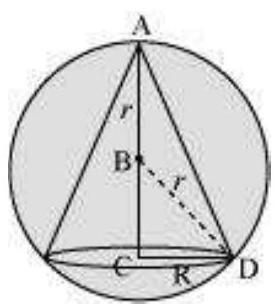
The volume $(V)$ of the cone is given by,
$V=\frac{1}{3} \pi R^{2} h$
Now, from the right triangle $B C D$, we have:
$BC=\sqrt{r^{2}-R^{2}}$
$\square h=r+\sqrt{r^{2}-R^{2}}$
$ \begin{aligned} & \therefore V=\frac{1}{3} \pi R^{2}(r+\sqrt{r^{2}-R^{2}})=\frac{1}{3} \pi R^{2} r+\frac{1}{3} \pi R^{2} \sqrt{r^{2}-R^{2}} \\ & \begin{aligned} \therefore \frac{d V}{d R} & =\frac{2}{3} \pi R r+\frac{2 \pi}{3} \pi R \sqrt{r^{2}-R^{2}}+\frac{R^{2}}{3} \cdot \frac{(-2 R)}{2 \sqrt{r^{2}-R^{2}}} \\ & =\frac{2}{3} \pi R r+\frac{2 \pi}{3} \pi R \sqrt{r^{2}-R^{2}}-\frac{R^{3}}{3 \sqrt{r^{2}-R^{2}}} \\ & =\frac{2}{3} \pi R r+\frac{2 \pi R(r^{2}-R^{2})-\pi R^{3}}{3 \sqrt{r^{2}-R^{2}}} \\ & =\frac{2}{3} \pi R r+\frac{2 \pi R r^{2}-3 \pi R^{3}}{3 \sqrt{r^{2}-R^{2}}} \end{aligned} \end{aligned} $
Now, $\frac{d V}{d R^{2}}=0$
$\Rightarrow \frac{2 \pi r R}{3}=\frac{3 \pi R^{3}-2 \pi R r^{2}}{3 \sqrt{r^{2}-R^{2}}}$
$\Rightarrow 2 r \sqrt{r^{2}-R^{2}}=3 R^{2}-2 r^{2}$
$\Rightarrow 4 r^{2}(r^{2}-R^{2})=(3 R^{2}-2 r^{2})^{2}$
$\Rightarrow 4 r^{4}-4 r^{2} R^{2}=9 R^{4}+4 r^{4}-12 R^{2} r^{2}$
$\Rightarrow 9 R^{4}-8 r^{2} R^{2}=0$
$\Rightarrow 9 R^{2}=8 r^{2}$
$\Rightarrow R^{2}=\frac{8 r^{2}}{9}$
Now, $\frac{d^{2} V}{d R^{2}}=\frac{2 \pi r}{3}+\frac{3 \sqrt{r^{2}-R^{2}}(2 \pi r^{2}-9 \pi R^{2})-(2 \pi R r^{2}-3 \pi R^{3})(-6 R) \frac{1}{2 \sqrt{r^{2}-R^{2}}}}{9(r^{2}-R^{2})}$
$ =\frac{2 \pi r}{3}+\frac{3 \sqrt{r^{2}-R^{2}}(2 \pi r^{2}-9 \pi R^{2})+(2 \pi R r^{2}-3 \pi R^{3})(3 R) \frac{1}{2 \sqrt{r^{2}-R^{2}}}}{9(r^{2}-R^{2})} $
Now, when $R^{2}=\frac{8 r^{2}}{9}$, it can be shown that $\frac{d^{2} V}{d R^{2}}<0$.
$\square$ The volume is the maximum when
$ R^{2}=\frac{8 r^{2}}{9} $
When $R^{2}=\frac{8 r^{2}}{9}$, height of the cone $=r+\sqrt{r^{2}-\frac{8 r^{2}}{9}}=r+\sqrt{\frac{r^{2}}{9}}=r+\frac{r}{3}=\frac{4 r}{3}$.
Hence, it can be seen that the altitude of the right circular cone of maximum volume that can be inscribed in a sphere of radius $r$ is $\frac{4 r}{3}$.
13. Let $f$ be a function defined on $[a, b]$ such that $f^{\prime}(x)>0$, for all $x \in(a, b)$. Then prove that $f$ is an increasing function on $(a, b)$.
Show Answer
Solution
Let us take any 2 points $\mathrm{c}_1$ and $\mathrm{c}_2$ such that
${\mathrm{c} _1, \mathrm{c} _2} \in(\mathrm{a}, \mathrm{b})$ and
$\mathrm{c} _2=\mathrm{c} _1+\mathrm{h}$,
where $\mathrm{h} \rightarrow \mathrm{O}$
Now, $f^{\prime}\left(c _1\right)=\lim _{h \rightarrow 0} \frac{f\left(c _1+h\right)-f\left(c _1\right)}{h}=\frac{f\left(c _2\right)-f\left(c _1\right)}{c _2-c _1}$
Now, it is given that $\mathrm{f}^{\prime}(\mathrm{x})>0 \quad \forall \mathrm{x} \in(\mathrm{a}, \mathrm{b})$. Therefore, $\mathrm{f}^{\prime}\left(\mathrm{c}_1\right)>0$
$\Rightarrow \frac{\mathrm{f}\left(\mathrm{c}_2\right)-\mathrm{f}\left(\mathrm{c}_1\right)}{\mathrm{c}_2-\mathrm{c}_1}>\mathrm{O}$
From the above fraction, we can conclude that:
1. For $\mathrm{c}_2>\mathrm{c}_1, \mathrm{f}\left(\mathrm{c}_2\right)>\mathrm{f}\left(\mathrm{c}_1\right)$
2. For $c_1>c_2, f\left(c_1\right)>f\left(c_2\right)$
Hence, $\mathrm{f}(\mathrm{x})$ is an increasing function in $(\mathrm{a}, \mathrm{b})$.
14. Show that the height of the cylinder of maximum volume that can be inscribed in a sphere of radius $R$ is $\frac{2 R}{\sqrt{3}}$. Also find the maximum volume.
Show Answer
Solution
A sphere of fixed radius $(R)$ is given.
Let $r$ and $h$ be the radius and the height of the cylinder respectively.
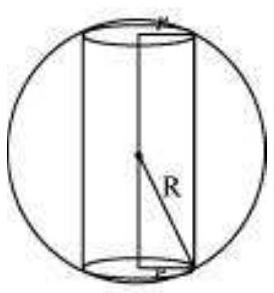
From the given figure, we have $h=2 \sqrt{R^{2}-r^{2}}$.
The volume $(V)$ of the cylinder is given by,
$ \begin{aligned} & V=\pi r^{2} h=2 \pi r^{2} \sqrt{R^{2}-r^{2}} \\ & \begin{aligned} \therefore \frac{d V}{d r} & =4 \pi r \sqrt{R^{2}-r^{2}}+\frac{2 \pi r^{2}(-2 r)}{2 \sqrt{R^{2}-r^{2}}} \\ & =4 \pi r \sqrt{R^{2}-r^{2}}-\frac{2 \pi r^{3}}{\sqrt{R^{2}-r^{2}}} \\ & =\frac{4 \pi r(R^{2}-r^{2})-2 \pi r^{3}}{\sqrt{R^{2}-r^{2}}} \\ & =\frac{4 \pi r R^{2}-6 \pi r^{3}}{\sqrt{R^{2}-r^{2}}} \end{aligned} \end{aligned} $
Now, $\frac{d V}{d r}=0 \Rightarrow 4 \pi r R^{2}-6 \pi r^{3}=0$
$\Rightarrow r^{2}=\frac{2 R^{2}}{3}$
Now, $\frac{d^{2} V}{d r^{2}}=\frac{\sqrt{R^{2}-r^{2}}(4 \pi R^{2}-18 \pi r^{2})-(4 \pi r R^{2}-6 \pi r^{3}) \frac{(-2 r)}{2 \sqrt{R^{2}-r^{2}}}}{(R^{2}-r^{2})}$
$ \begin{aligned} & =\frac{(R^{2}-r^{2})(4 \pi R^{2}-18 \pi r^{2})+r(4 \pi r R^{2}-6 \pi r^{3})}{(R^{2}-r^{2})^{\frac{3}{2}}} \\ & =\frac{4 \pi R^{4}-22 \pi r^{2} R^{2}+12 \pi r^{4}+4 \pi r^{2} R^{2}}{(R^{2}-r^{2})^{\frac{3}{2}}} \end{aligned} $
Now, it can be observed that at $r^{2}=\frac{2 R^{2}}{3}, \frac{d^{2} V}{d r^{2}}<0$.
$\square$ The volume is the maximum when $r^{2}=\frac{2 R^{2}}{3}$.
When $r^{2}=\frac{2 R^{2}}{3}$, the height of the cylinder is $2 \sqrt{R^{2}-\frac{2 R^{2}}{3}}=2 \sqrt{\frac{R^{2}}{3}}=\frac{2 R}{\sqrt{3}}$.
Hence, the volume of the cylinder is the maximum when the height of the cylinder is $\frac{2 R}{\sqrt{3}}$.
15. Show that height of the cylinder of greatest volume which can be inscribed in a right circular cone of height $h$ and semi vertical angle $\alpha$ is one-third that of the cone and the greatest volume of cylinder is $\frac{4}{27} \pi h^{3} \tan ^{2} \alpha$.
Show Answer
Solution
The given right circular cone of fixed height $(h)$ and semi-vertical angle ( $a$ ) can be drawn as:
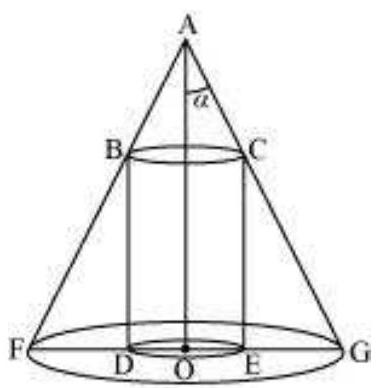
Here, a cylinder of radius $R$ and height $H$ is inscribed in the cone.
Then, $\square GAO=a, OG=r, OA=h, OE=R$, and $CE=H$.
We have,
$r=h \tan a$
Now, since $\triangle AOG$ is similar to $\triangle CEG$, we have:
$\frac{AO}{OG}=\frac{CE}{EG}$
$\Rightarrow \frac{h}{r}=\frac{H}{r-R} \quad[EG=OG-OE]$
$\Rightarrow H=\frac{h}{r}(r-R)=\frac{h}{h \tan \alpha}(h \tan \alpha-R)=\frac{1}{\tan \alpha}(h \tan \alpha-R)$
Now, the volume $(V)$ of the cylinder is given by,
$V=\pi R^{2} H=\frac{\pi R^{2}}{\tan \alpha}(h \tan \alpha-R)=\pi R^{2} h-\frac{\pi R^{3}}{\tan \alpha}$
$\therefore \frac{d V}{d R}=2 \pi R h-\frac{3 \pi R^{2}}{\tan \alpha}$
Now, $\frac{d V}{d R}=0$
$\Rightarrow 2 \pi R h=\frac{3 \pi R^{2}}{\tan \alpha}$
$\Rightarrow 2 h \tan \alpha=3 R$
$\Rightarrow R=\frac{2 h}{3} \tan \alpha$
Now, $\frac{d^{2} V}{d R^{2}}=2 \pi h-\frac{6 \pi R}{\tan \alpha}$
And, for $R=\frac{2 h}{3} \tan \alpha$, we have:
$\frac{d^{2} V}{d R^{2}}=2 \pi h-\frac{6 \pi}{\tan \alpha}(\frac{2 h}{3} \tan \alpha)=2 \pi h-4 \pi h=-2 \pi h<0$
$\square$ By second derivative test, the volume of the cylinder is the greatest when
$R=\frac{2 h}{3} \tan \alpha$.
When $R=\frac{2 h}{3} \tan \alpha, H=\frac{1}{\tan \alpha}(h \tan \alpha-\frac{2 h}{3} \tan \alpha)=\frac{1}{\tan \alpha}(\frac{h \tan \alpha}{3})=\frac{h}{3}$.
Thus, the height of the cylinder is one-third the height of the cone when the volume of the cylinder is the greatest.
Now, the maximum volume of the cylinder can be obtained as:
$\pi(\frac{2 h}{3} \tan \alpha)^{2}(\frac{h}{3})=\pi(\frac{4 h^{2}}{9} \tan ^{2} \alpha)(\frac{h}{3})=\frac{4}{27} \pi h^{3} \tan ^{2} \alpha$
Hence, the given result is proved.
16. A cylindrical tank of radius $10 m$ is being filled with wheat at the rate of 314 cubic metre per hour. Then the depth of the wheat is increasing at the rate of
(A) $1 m / h$
(B) $0.1 m / h$
(C) $1.1 m / h$
(D) $0.5 m / h$
Show Answer
Solution
Let $r$ be the radius of the cylinder.
Then, volume $(V)$ of the cylinder is given by,
$V=\pi(\text{ radius })^{2} \times$ height
$ \begin{matrix} =\pi(10)^{2} h & (\text{ radius }=10 m) \\ =100 \pi h \end{matrix} $
Differentiating with respect to time $t$, we have:
$\frac{d V}{d t}=100 \pi \frac{d h}{d t}$
The tank is being filled with wheat at the rate of 314 cubic metres per hour.
$ \square \frac{d V}{d t}=314 m^{3} / h $
Thus, we have:
$ \begin{aligned} & 314=100 \pi \frac{d h}{d t} \\ & \Rightarrow \frac{d h}{d t}=\frac{314}{100(3.14)}=\frac{314}{314}=1 \end{aligned} $
Hence, the depth of wheat is increasing at the rate of $1 m / h$.
The correct answer is $A$.










